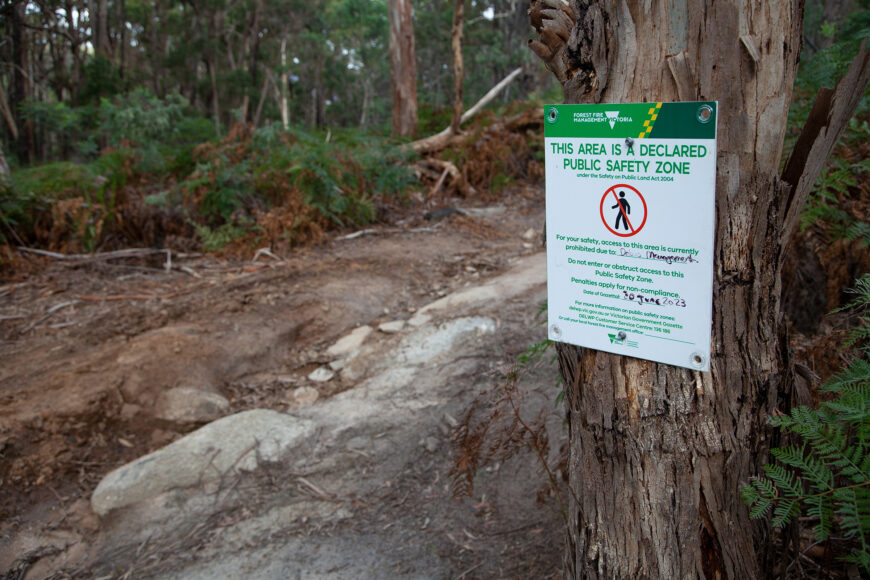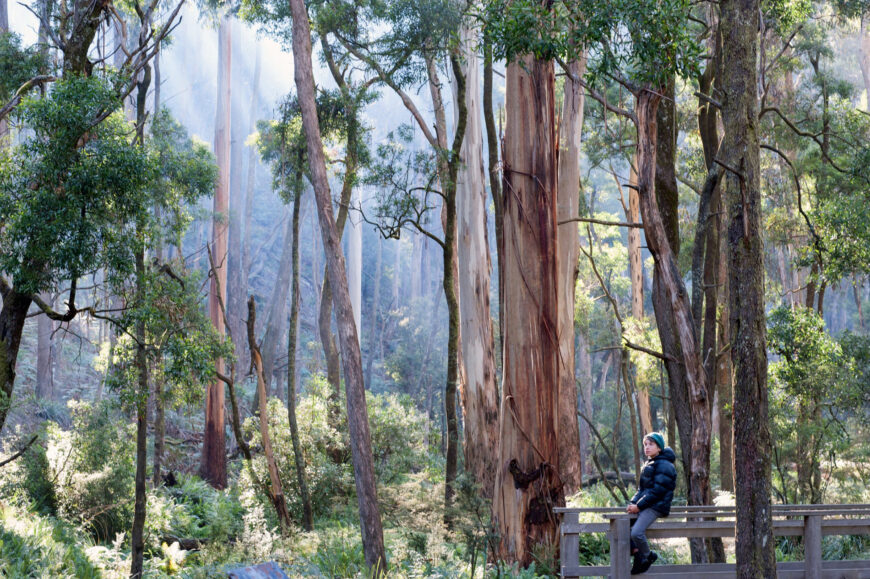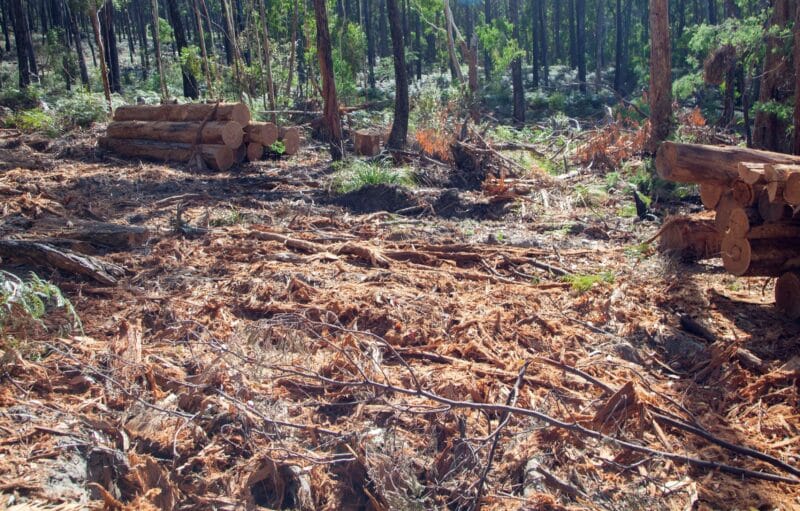PARK WATCH Article June 2023 |
VNPA Executive Director Matt Ruchel asks if rogue logging will become the next forest-eating monster now we’ve (almost) banished VicForests
Due to the impact of a series of community court cases, large-scale commercial logging will cease across the state at the end of this year. State agency VicForests lost its social licence to operate after years of haemorrhaging taxpayer money and running roughshod over community concerns.
But now a new form of logging is on the rise. In many ways it’s as equally rogue and could be as equally damaging if not managed and regulated. It appears our state leaders haven’t learnt the lessons of decades of battles to end industrial native forest logging. We need the opposite, not the same again under a different name.
VNPA has been tracking ‘salvage logging’ as well as fire prevention and ‘clean up’ works across the state. We’re seeing operations in established national parks (Dandenong Ranges National Park), in promised national parks (Wombat Forest) and conservation areas, the Cobaws and even the closed Silvan water catchment.
These so-called ‘clean ups’ are being done in response to windstorm damage that occurred almost two years ago. Windthrown trees are being taken for commercial purposes, even out of national parks, where the natural decay of trunks and branches have long been considered a normal, healthy ecological process. In some instances, the sites are already in recovery, and it is hard to see any need for salvage. In reality, it appears that useable timber logs are the real target.

Climate science tells us that weather and fire are becoming more frequent and intense. While we will always need to protect human life and respond to emergencies, we need a truly thoughtful approach to how that happens. Nature is part of the climate solution, not the enemy; it would be a failure of governance to end up in a world of human-made climate disaster logging, just because the opportunity is there.
How do we avoid a world like that? The first step is to make sure our nature protection laws and legal structures are fit for purpose. The current policy and approval architecture of how fire preparation works get the green light is very opaque.
In Victoria, the Forests Act 1958 requires the Secretary of the Department of Energy, Environment and Climate Action (DEECA) to carry out proper and sufficient work in state forests, national parks and other protected public land to prevent and suppress bushfires. This is a significant head of power, but it can be abused. It makes sense when fighting a wildfire in the depths of summer but what about in the depths of winter, in the name of fire prevention, especially when logs are being sold and money being made? A lack of scrutiny is what makes dubious actions not only possible but enticing to some.
It seems Forest Fire Management Victoria (FFMV), through the Secretary, has almost unlimited powers. A recent decision to ‘shift and lift’ over 100 specialist fire staff from Parks Victoria into FFMV has further consolidated that fire power.
The Forests Act provisions give FFMV the power to do what they choose, largely without scrutiny. FFMV states on various websites and public documents that they do assess for impacts on threatened plants and animals and other ecological features, but these assessments are not made public.
Works conducted under the guise of fire mitigation are not subject to the normal guidelines for forestry practice set out in the Western Regional Forests Agreement (RFA). Nor are they present in the Sustainable Forestry Timber Act or even the minimum standards set out in Code of Practice for Timber Production. At a state level there is no independent oversight of the ecological implications of fire-related management from other agencies such as the Office of the Conservation Regulator, which oversees VicForests.
There is a Code of Practice for Bushfire Management on Public Land (last updated in 2022), but it doesn’t explicitly mention these types of works. It talks vaguely and bureaucratically about ‘continuing public land stabilisation activities’, ‘identifying, assessing and treating any further risks …including risks to natural and cultural values’ and ‘undertaking works that facilitate access to public land and the recovery of natural, cultural and built assets’.
While most people would recognise that strong powers are needed during an emergency, these powers should surely be proportional once the emergency is past and subject to a thorough and transparent process to assess ecological impact. Most other industries are assessed, especially for large projects.
Unlike forestry, these types of works are in theory subject to the Environment Protection and Biodiversity Conservation Act 1999 even though it looks a lot like forestry, uses the same contractors, machinery and methods and the wood for commercial use. National environmental law do not apply to forestry under RFAs, but they are supposed to apply to every thing else including fire preparation works.

When we raise these issues with the federal environment minister, she responded thus:
I understand that DEECA has undertaken a self-assessment to identify relevant protected environmental values and implement appropriate management controls and will refer proposals if a significant impact on a protected matter is likely to occur.
This approach is vastly different to the federal department’s on similar fire related projects in the past. In 2007/8, strategic fuel breaks in the Yarra Ranges were referred to the Commonwealth department. While the Commonwealth decided they didn’t require further public assessment, they did put more than a dozen conditions on the works to protect key nationally listed species. This was a bare minimum of protection.
The public surely would require more caution for large-scale works in Dandenong Ranges National Park, which has records of at least eight nationally-listed threatened plants and animals.
‘Salvage logging’ appears to be treated using the same process as a strategic fuel break program. These have a distinct ‘Planning and Approval Framework’, that empowers DEECA/FFMV to make assessments for threatened wildlife and other environmental values, which are signed off by the chief fire officer and a regional DEECA director. These are not public documents; there is no transparent process of approval nor any opportunity for public scrutiny. When we asked for copies of documents, the response was that they are available under Freedom of Information, a lengthy, subjective, and uncertain process.
The scale of salvage works proposed in the Wombat, Cobaws and Dandenong Ranges is huge. While complaints from VNPA and the local community have slowed some of this, any other project or program of this size would have had a full Environmental Effects Statement – or at least some comprehensive public process. But as far as we can tell, except for some rushed local consultation, little publicly available assessment of ecological impacts has been undertaken.
In a web search for the opposite of ‘rogue’, words like aboveboard, honest, credible and exemplary pop up. We need a system that abides by these hallmarks, not a return to rogue logging.
Donate to help stop rogue logging
- Read the latest full edition of Park Watch magazine
- Subscribe to keep up-to-date about this and other nature issues in Victoria
- Become a member to receive Park Watch magazine in print
